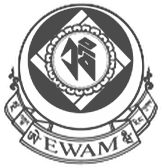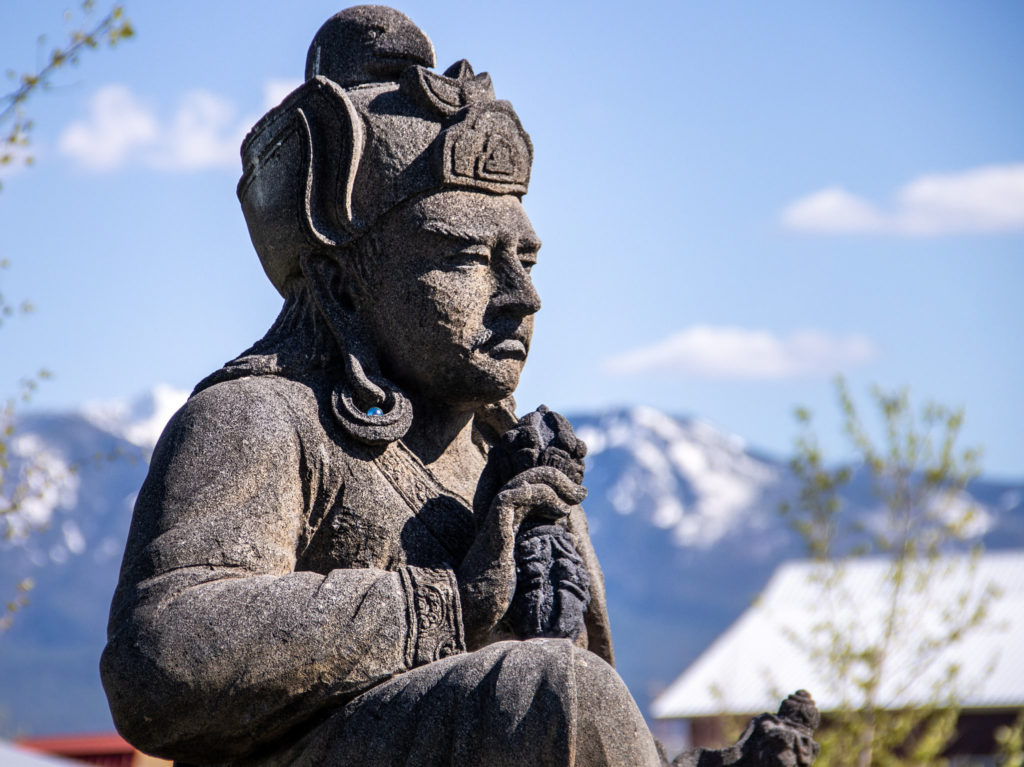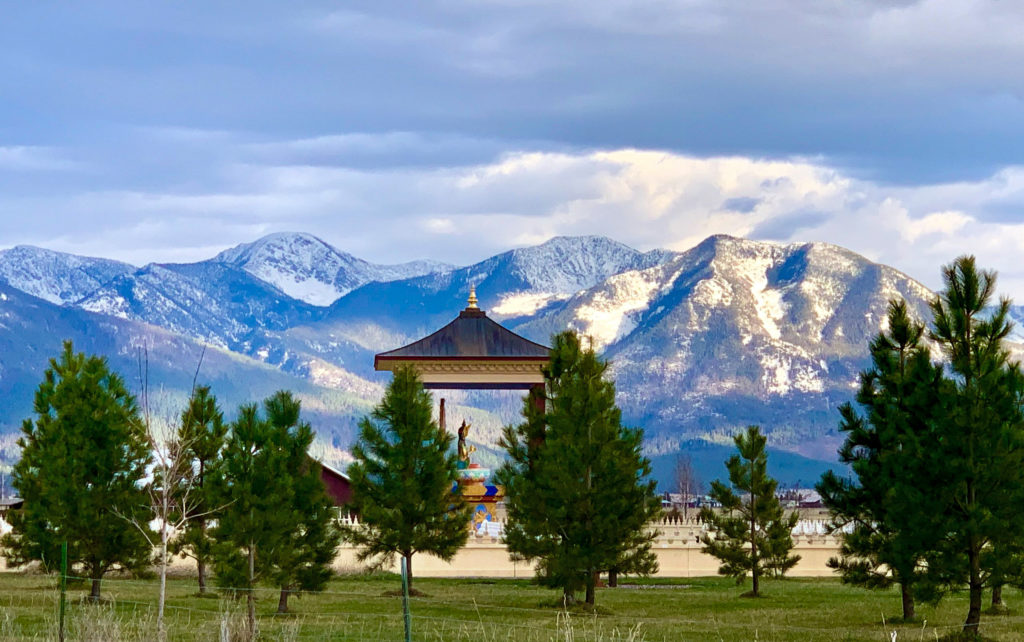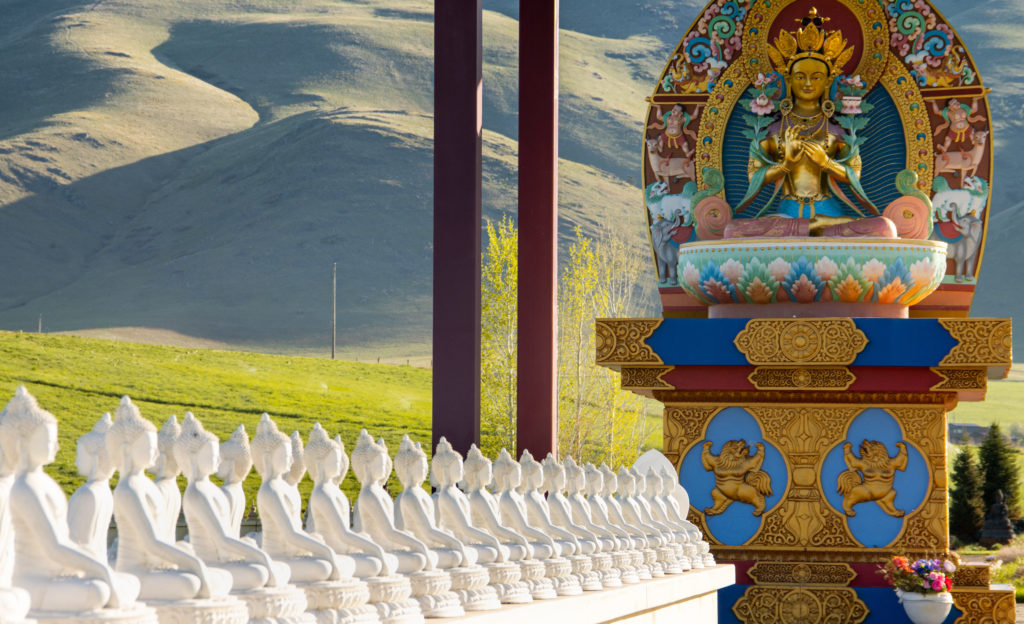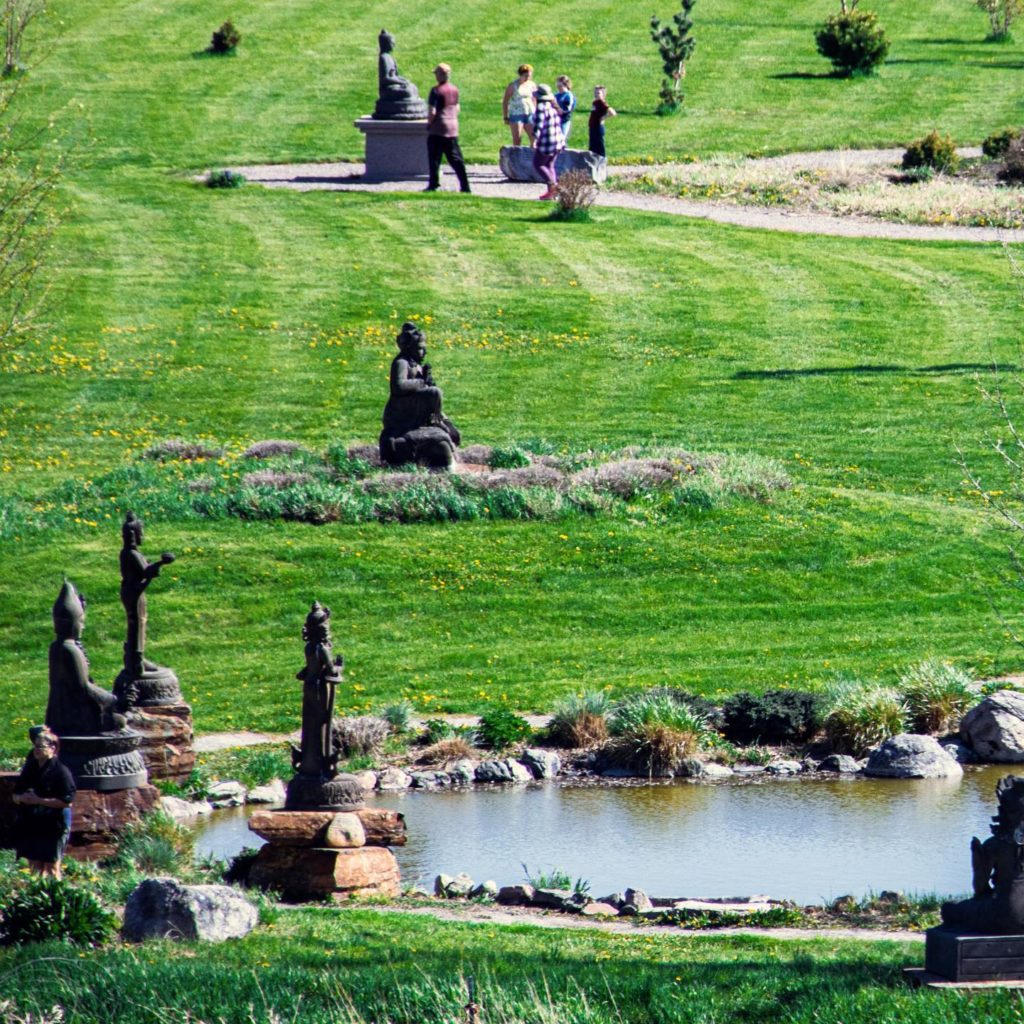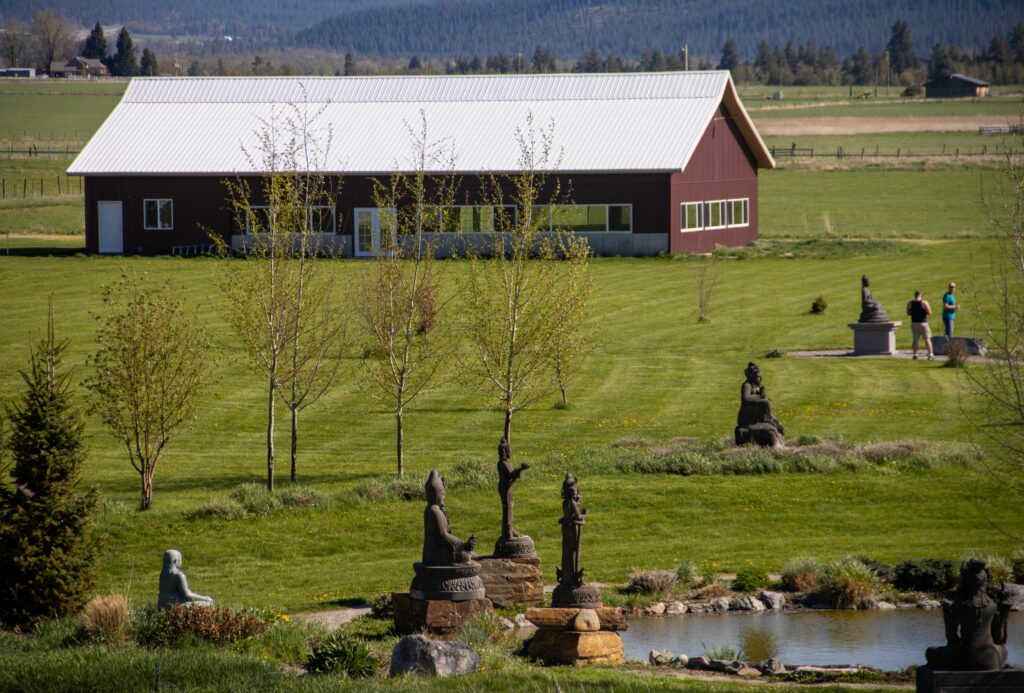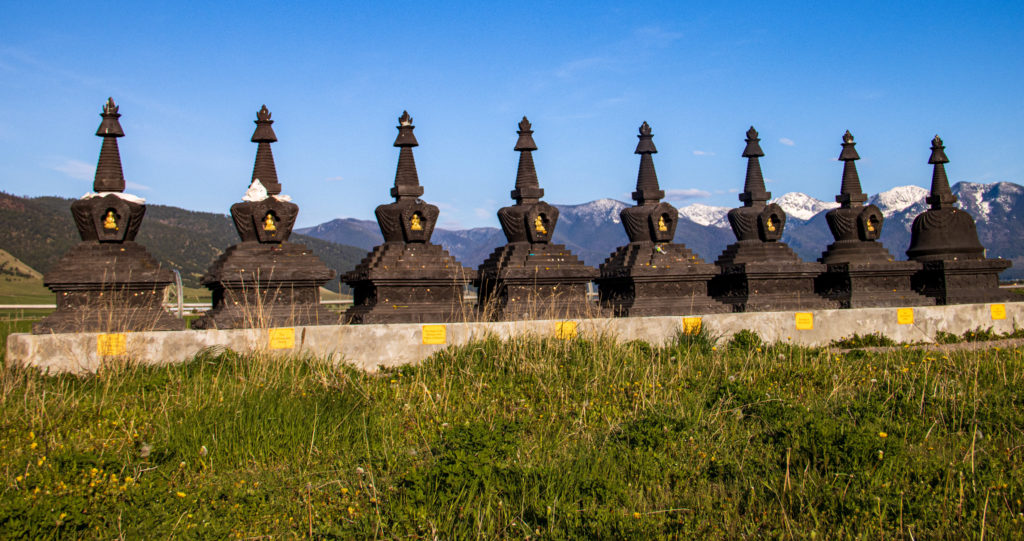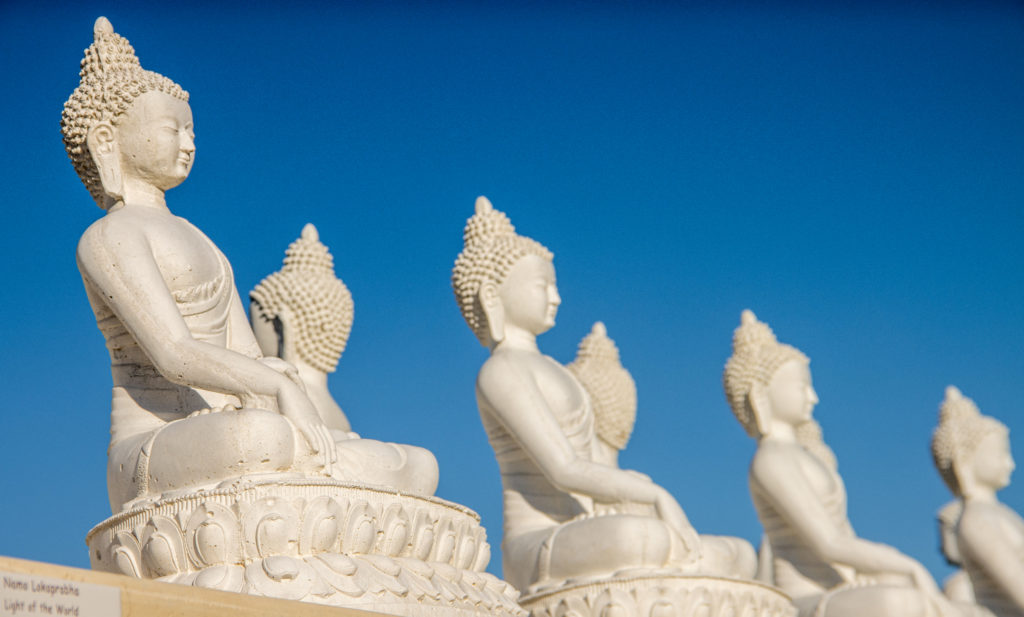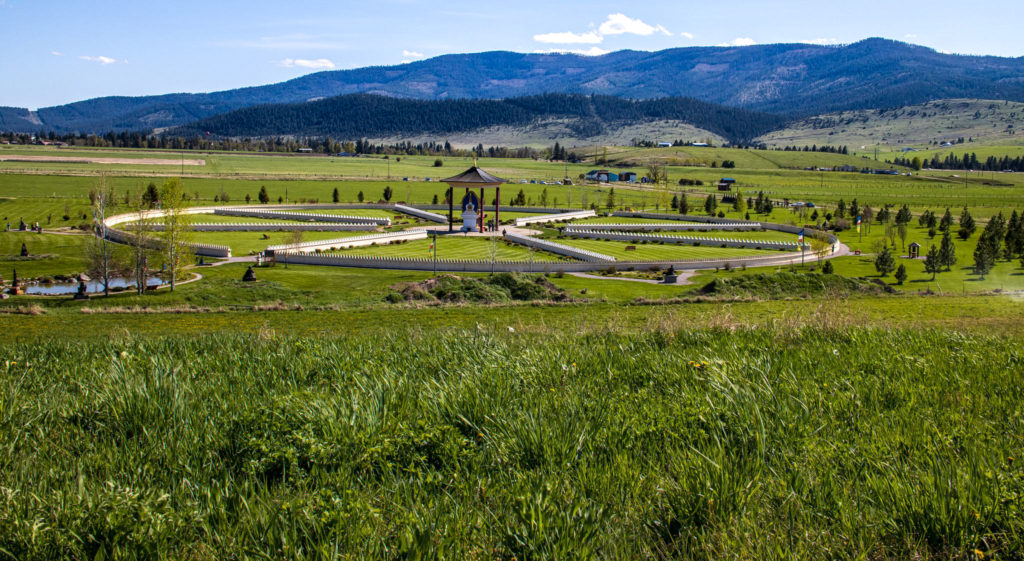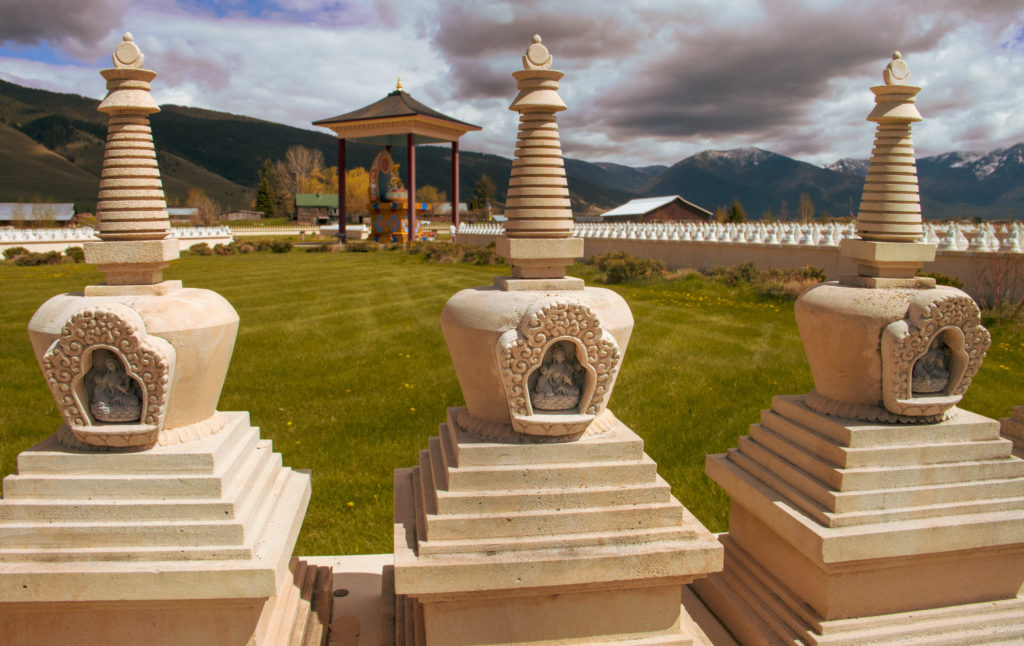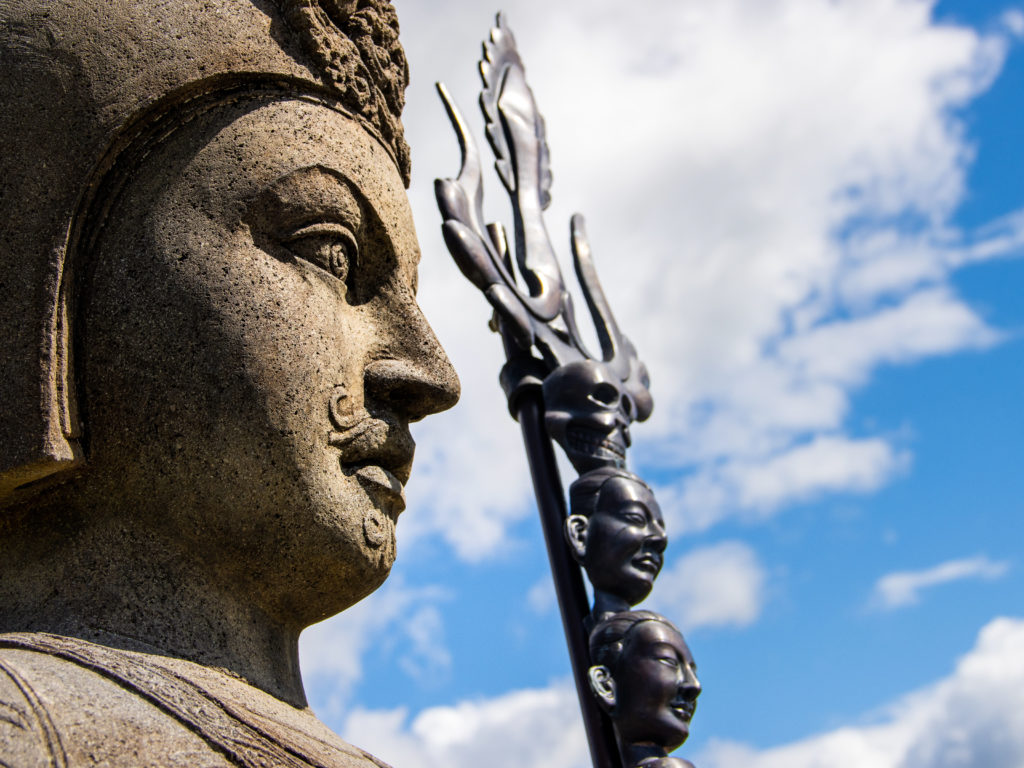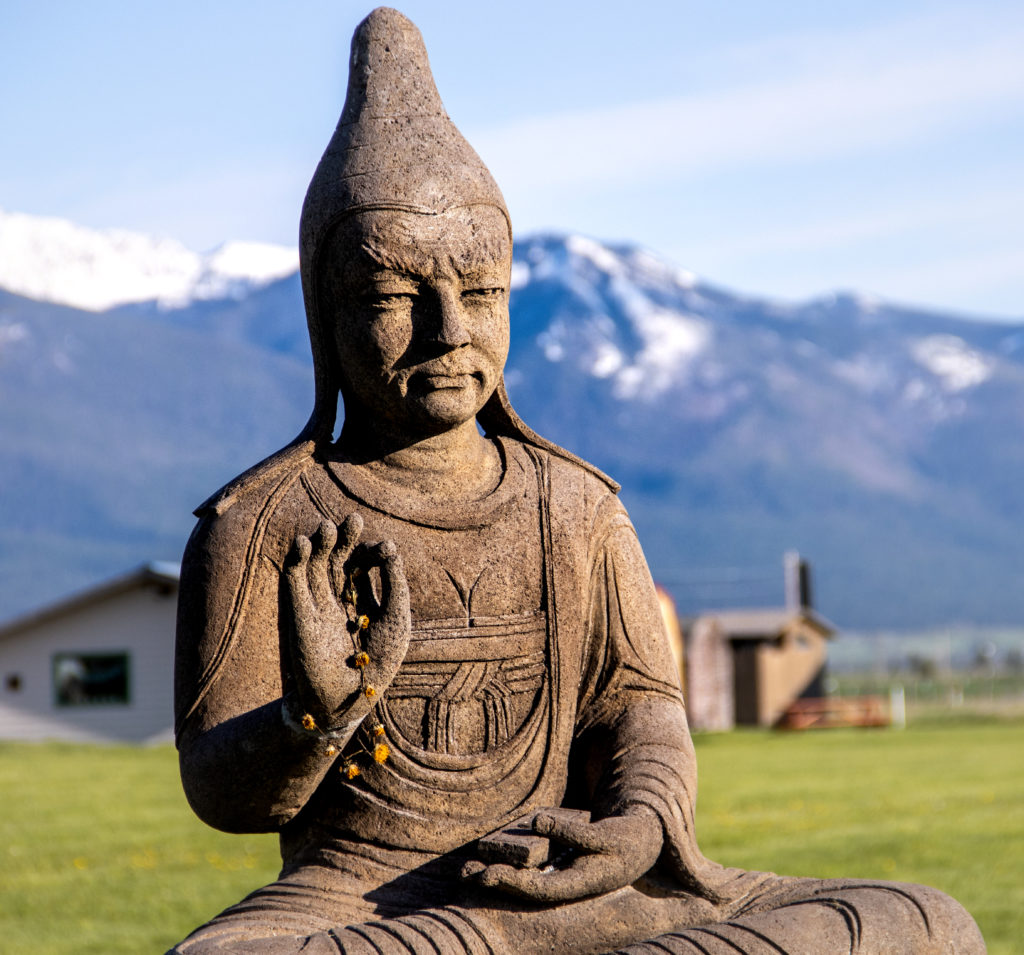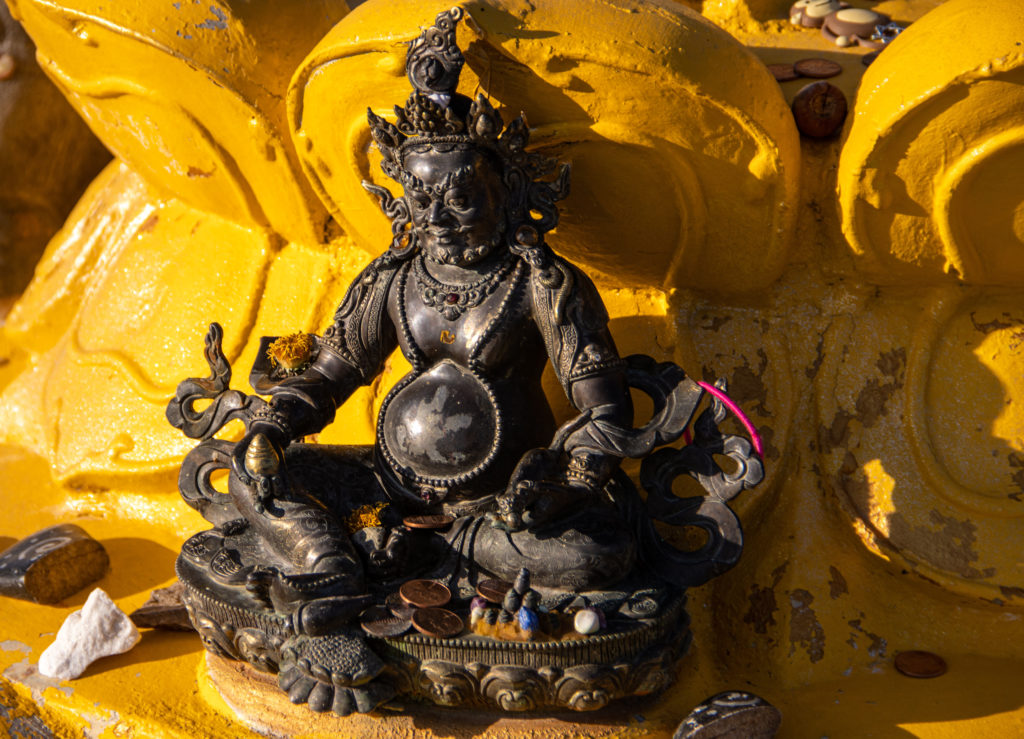The Garden of One Thousand Buddhas is in western Montana’s spectacular Jocko Valley, just north of Missoula. Nestled in a peaceful valley in the land of the Confederated Salish and Kootenai Tribes of the Flathead Reservation, near Glacier National Park and medicinal hot springs. The location and architecture of the garden was a prophetic treasure vision that Sang-ngag Rinpoche had while a child and was discovered while on a trip to teach the dharma in Montana.
The Garden of One Thousand Buddhas is a public park, botanical garden and Buddhist center in the Nyingma School of Tibetan Buddhism. The Garden of One Thousand Buddhas in western Montana’s Jocko Valley, just north of Arlee, is led by the visionary guidance of Gochen Tulku Sang-ngag Rinpoche. Nestled in a peaceful valley in the land of the Confederated Salish and Kootenai Tribes of the Flathead Reservation, the Garden of One Thousand Buddhas aligns positive properties of the physical world in a sacred architectural arrangement based on the eight-spoked Dharma wheel. This symbol evokes the turning or awakening of the enlightened qualities of altruism and wisdom.
The purpose of the garden is to bring about positive transformation within those who visit, in response to the negativity that abounds in the world today. One thousand hand-cast Buddha statues are arrayed around the central figure of Yum Chenmo (Prajnaparamita), or the Great Mother, the manifestation of the perfection of wisdom. One thousand stupas, representations of the enlightened mind line the outer circle. Each enshrines an image of the female deity, Tara. The garden is elegantly adorned with native trees, flowers and other other inspiring landscape features. The Garden of One Thousand Buddhas instills lasting impressions of wisdom and compassion. The garden is also the home of the Ewam Buddhist Institute founded by Sang-ngag Rinpoche and Khen Rinpoche and their landmark summer shedra program. You can also follow the gardens activities and community on Facebook and Instagram #ewambuddhagarden.
Gochen Tulku Sang-ngag Rinpoche: Spiritual Director/Founder of Ewam International
Khenpo Ngawang Namchak: President
Tsering Karchungtsang: Vice President
Sonam Sangmo: Secretary
Jetsunma Jamyang Yeshe Palmo: Treasurer
Melong Baldwin: Member
Khenpo Ngawang Namchak: Garden Abbot
Tsering Karchungtsang: Executive Director/Office Administrator
Tours are offered when available April thru October. For special group tours, or to find out about having your wedding or event at the garden, please contact admin@ewam.org.
Visitors are welcome every day. A visitor’s guide to Garden is available for download. Garden of One Thousand Buddhas Visitor’s Guide
Garden Open Hours:
Spring (March, April, May: 9am-7pm)
Summer (June, July, August: 9am-9pm)
Autumn (September, October: 9am-7pm)
Winter (November, December, January, February: 9am-5pm)
Parking for the garden is located at 34756 White Coyote Road, Arlee, MT 59821. It is a sacred place. In order that the Garden be kept clean for visitors and safe for all ages, we ask that you leave your pets at home, or board them, or leave them in your car, only if the temperature is appropriate for them. Dogs should not be left in the car during extreme heat or cold in the summer or winter months.
Within the Garden of One Thousand Buddhas rests the inspiring central figure of Yum Chenmo. She is also known as The Great Mother of Transcendent Wisdom. One thousand Montana-made images of the Buddha, arranged in the shape of an eight-spoked Dharma wheel, encircle Yum Chenmo. In addition to the thousand Buddhas, one thousand stupas surmount the two exterior throne walls, creating the outer rim of the Dharma wheel, or Dharmachakra. This is a meaningful ancient symbol from India which has come to be associated with the Buddha’s teachings (dharma) when he “turned the wheel (chakra),” setting in motion the teachings on the path to liberation and enlightenment. The dharma wheel literally represents the wheel of transformation; spiritual change; the turning toward awakening. The directions in which the eight spokes radiate represent the Buddhist noble eight-fold path of right view, right intention, right speech, right action, right livelihood, right effort, right mindfulness, and right concentration.
Yum Chenmo/Prajnaparamita/The Great Mother
Seated at the center point of the Garden of One Thousand Buddhas is the 24-foot tall figure of Yum Chenmo, or Prajnaparamita in Sanskrit meaning Transcendent Perfection of Wisdom. She is depicted in feminine form because it is this perfect wisdom which gives birth to all of the Buddhas, as well as the bodhisattvas, those who are striving for enlightenment to benefit all beings. Yum Chenmo represents the union of primordial wisdom and the skillful means of compassion.
One Thousand Buddhas
According to the Buddhist texts, we are living in an enormous cycle of time known as The Fortunate Aeon. It is fortunate because it is believed that one thousand Buddhas will take birth, attain enlightenment, and teach the path to liberation. Of these one thousand, the Buddha of our particular time, Shakyamuni, is only the fourth to have descended on Earth. It is further explained that all of the one thousand Buddhas will attain enlightenment at the site now known as BodhGaya, in India. Montana’s Garden of One Thousand Buddhas embodies the pure reflection of Bodh Gaya to benefit those who may never have the chance to travel to India.
One Thousand Stupas
The stupa is one of the world’s oldest architectural forms. Originally constructed as reliquaries to honor the remains of great kings and warriors, evolving in sophistication since the time of Shakyamuni Buddha stupas have enshrined the relics of enlightened masters. The one thousand stupas which encircle the garden are in the style known as the stupa of enlightenment. Each element, from the base to the tip of the spire, represents an aspect of the path to enlightenment, collectively symbolizing the mind of awakening. Each of these one thousand stupas also enshrine an image of the female deity Tara, serving as a potent reminder that spiritual liberation is equally the birthright of all beings.
Sangwa Yeshé Drubchöd
In the 9thcentury at the Drakmar Kyeu-tsang cave of Samye Chimphu in Tibet, Guru Rinpoche bestowed the sacred teachings of the Gathering of Sughatas. One of these rare and precious cycles of tantric instruction and practice was the Sangwe Yeshe (secret wisdom) cycle given to the dakini Yeshe Tsogyal and Nupchen Sangye Yeshe, one of the heart sons among the 25 disciples of Guru Rinpoche.
This practice was concealed in the rocks of these caves, Samye Chimpu and Drigung Tidro, by Yeshe Tsogyal as terma (spiritual treasures) to be revealed at a future time when the practices would be of the most benefit. It was prophesized that the future incarnation of Nupchen Sangwe Yeshe would be the revealer (terton) of these terma. Over 800 years later, in 1716, the great Terton Tsasum Lingpa, the re-incarnation of Nubchen Sangye Yeshe would open the secret doors of these places and reveal the terma.
Sangwe Yeshe, a nirmanakaya form of Vajravarahi is the great wisdom dakini, a manifestation of the enlightened feminine principal. The benefits of realization, long life, good health, prosperity, power, wish fulfillment, and the removal of obstacles are some of the results of this practice. Drubchod or the great accomplishment ceremony is an especially potent group format of deity practice to awaken one to the perception of one’s own true nature and the whole world as a sacred realm.
This nine day group practice will be led by Vajra Master Tulku Sang-ngag Rinpoche, founder and spiritual director of Ewam centers worldwide. Other great Buddhist masters who will be teaching during this Drubchod practice are Namchak Khen Rinpoche who is the resident Abbot at the Ewam Garden of One Thousand Buddhas, Khenpo Namchak Dorji and Jestunma Pema Yeshe Palmo. The Drubchod is accomplished in four daily sessions held right in front of the central statue, Great Mother of Wisdom (Prajnaparamita), on the ground of the Garden of One Thousand Buddhas.
This Drubchod is open to all levels of practitioner including beginners. There will be teachings and instructions throughout offering explanations and instructions.
Bodhicitta Monlam
International Prayer Ceremony (Bodhicitta Monlam). Free and open to all – please arrive a few minutes early and take your seat. Weather permitting will be held in front of the main garden statue, if raining inside outdoor tent near the gift shop. We are annually offering 100,000 Bodhicitta prayers for the flourishing of the collective merit of the world to pacify the disturbance in the elements of our world for peace and happiness. The purpose of the Mönlam is to liberate all sentient beings from suffering.
Tibetan Cultural Festival
Peace Festival
The gift shop is located onsite, offering imported treasures from Nepal, Buddhist shrine items, books, clothing, jewelry, local crafts, and much more.
GIFT SHOP HOURS:
Summer Hours: 10am to 6pm.
Winter Hours: 10am to 5 pm.
Open on weekends: 10am to 5 pm.
For more information please email: admin@ewam.org
Garden of One Thousand Buddhas
Internship Announcements and Open Positions Currently Accepting Applications at the Garden of One Thousand Buddhas
According to the directive announced by Tulku Sangak Tenzin Rinpoche, the Supreme Head of Namchak Lineage, on the 22 of 02 2020, Namchak Khen Rinpoche Ngawang Gelek has been appointed as person in charge of the Garden of Thousand Buddhas. All the decisions including appointments and related details will be made in consultation with Khen Rinpoche.
Ewam Garden of One Thousand Buddhas is one of Montana’s leading tourist sites. Ewam provides an ideal environment for those who want to work with and practice Tibetan Buddhism. Our main goal is to take great care and to provide a peaceful and insightful place for all employees, volunteers, and visitors.
EWAM BUDDHA GARDEN – GARDEN HELPER
Background:
Ewam Garden of One Thousand Buddhas is one of Montana’s leading tourist sites. Ewam provides an ideal environment for those who want to work with and practice Tibetan Buddhism. Our main goal is to take great care and to provide a peaceful place for all employees, volunteers, and visitors.
Job Title: Garden Helper (Dates: TBA)
Compensation: $12 hour for 2 days-3 days per week from 9am to 6pm
Job Requirements:
Be at least 18 years of age;
hard working with a positive attitude.
Willing to learn, contribute and follow pre-established guidelines to perform assigned jobs;
Ability to operate lawnmower and other landscaping equipment.
Ability to operate basic power tools.
Ability to lift 70 pounds
Ability to prioritize tasks and process multiple tasks
Ability to live and share the responsibility with others in a communal living situation.
Job Functions:
Opening the Garden gate at 9 am and close it at appropriate times on daily basis.
Performing daily on-going maintenance of the Garden.
Performing grass mowing, cutting, weeding, raking, planting, statue cleaning and other basic maintenance.
Operating sprinkler system and watering specific areas of the Garden as needed, with irrigation system and/or by hand.
Performing cleaning of the pond and feeding fish on routine basis.
Performing daily cleaning and maintenance of the Garden public toilets.
Emptying trash cans from the main Garden properties and disposing at the trash site nearby.
Maintaining roads and paths in/out of the Garden in a safe and smooth condition.
Performing other general support of assigned tasks to the management, whenever needed.
Performing seasonal maintenance and cleaning of Garden equipment.
Ewam Gift Shop – Store Clerk
Job Title: Gift Store Clerk
Monthly Pay: $900.- with room accommodation (including utilities) at the garden and a food stipend.
Job Requirements:
Friendly with great integrity, sincerity, punctuality and strong work ethic.
Customer oriented with a good communication skills and professional positive attitude.
Detail oriented and precise accuracy with counting money and processing transactions.
Willing to learn and follow pre-established guidelines to perform the job.
Ability to prioritize tasks and process multiple tasks.
Ability to get along well with others in a communal living situation.
Job Functions:
Responsible for keeping the gift store open from 10am to 6pm, 5 days a week.
Register transactions, maintain general appearance and store cleanliness.
Assist customers in the in-store checkout process, handling cash, credit card or check transactions.
Issuing changes, receipts and refunds, packing item and occasionally mailing goods.
Responsible for a good sales record and keeping the shop well stocked.
Maintaining price accuracy.
Ensuring accurate cash account balance at closing everyday.
Submitting a sales report weekly and monthly.
Completing, processing and maintaining applicable paperwork and records of the store.
Relaying questions to management as needed.
Resolving customer complaints and providing guidance and relevant information to achieve customer satisfaction.
Greeting customers when entering and leaving the store.
Note:
l All positions include room and board in the scenic Jocko Valley near Missoula, MT.
l All the matters in relation with management of Garden of Thousand Buddhas should be finalized in consultation with Tsering Karchungtsang.
When Tulku Sang-ngag Rinpoche conceived the Garden of One Thousand Buddhas project in 2000, he expressed the aspiration that as many people as possible be allowed to participate as volunteers in this sacred place of pilgrimage in Montana.
Volunteer opportunities are available throughout the week and weekends outdoors in the Garden, such as weeding, gardening, and landscape work. Join our community for as much time as you can spare, whether it’s a few hours or a whole day. A fun way to accumulate merit, while helping to maintain this special place. Make your own hours. Call the Ewam office at: 1- 406-726-0555.
Taken a spectacular photo at the Garden? Doonate your photos and videos by emailing admin@ewam.org
Your photo could be chosen for our FaceBook or Instagram page, or our website!
Together we can grow this Garden for future generations!
–Gochen Tulku Sang-ngag Rinpoche
In July 2016, Sang-Ngag Rinpoche inaugurated the Ewam Buddhist Institute (Shedra) at the Garden of One Thousand Buddhas in Montana. Rinpoche was the first to teach Jigme Lingpa’s seminal text Treasury of Precious Qualities in its entirety in North America, which is the primary text in the summer Shedra curriculum.
The Garden also offers other retreats and courses in both philosophy and Buddhist practice. These programs offer a rare opportunity for theoretical and practice focused training in Buddhism.
Among these retreats is the very popular week long Sangwa Yeshe Drubchöd, followed by a live webcast of the International Bodhicitta Mönlam, offered annually in June.
And although not a teaching event, we would be remiss if we did not mention the Annual Peace Festival held each September, at the Garden of One Thousand Buddhas. This is a family friendly community event celebrated with food, music, vendors, speakers, and more. The event welcomes people of all traditions to enjoy a fun-filled day in an atmosphere of peace and kindness.
Although sometimes mistakenly considered to be solely focused on dark retreat, Yangti Nagpo is in fact an extensive cycle of spiritual trainings spanning the breadth of Tibetan Vajrayana practice. In Tulku Sang-ngag’s Yangti Gomde, students are trained in the many practices within the categories of ngondro, kyerim, dzogrim, and dzogchen. In both the old and new revelations of Yangti, dark retreat is the main emphasis, and the primary unique feature of these teachings, setting them apart from other Dzogchen cycles. But even though dark retreat is a major component of this cycle, it is not guaranteed that all students will in fact experience this type of retreat. Ewam Yangti Gomde is designed to impart a vast toolbox of spiritual practices. Which of these is chosen by the practitioner as a main or long-term practice depends on each student’s individual interests and aptitudes.
At the annual Yangti Gomde gathering held at the Garden of One Thousand Buddhas in Arlee, Montana, in addition to individual practice instruction, students receive ceremonial instruction and practice in the form of a drupchö (group ritual ceremony) over one week. The drupchö is based on the Yangti Shitro Sadhana (100 peaceful and wrathful deities), a central practice within Yangti Nagpo. The main purpose of the annual Yangti Gomde gathering is for students to be guided progressively through a series of trainings over a number of years. These trainings progress through the following sequence: 1-ngondro (preliminary practices) 2-tsasum (three roots) sadhana practices focused on kyerim (development stage) 3-tsalung (subtle channels and energies training) including tummo and trulkhor 4-Dzogchen (Great Perfection) practices including rushen, trekcho, and togel. Each section of teachings is taught by Tulku Sang-ngag with additional instruction given by both Tibetan and western practitioners. For more information please visit: Ewam Yangti Gomde.
